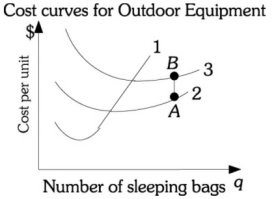In the long run, both monopolistically competitive and perfectly competitive firms attain
A) lowest cost production.
B) positive economic profits.
C) zero economic profits.
D) productive efficiency.
C
You might also like to view...
Which of the following statements is TRUE about the relationship among external, internal and social costs?
A) Social costs will always be higher than external costs. B) Social costs will always be higher than internal costs. C) Internal costs will always be higher than external costs. D) Internal costs will never equal external costs.
When demand is unit elastic
A) price and revenue move in opposite directions. B) price and revenue are not related. C) price and quantity demanded move in opposite directions. D) price and revenue move in the same direction.
A rise in the wage rate would cause
A. an increase in the MRP schedule of labor. B. a decrease in the MRP schedule of labor. C. no change in the MRP schedule of labor.
Refer to the information provided in Figure 8.6 below to answer the question(s) that follow.  Figure 8.6 Refer to Figure 8.6. Average fixed cost is represented by
Figure 8.6 Refer to Figure 8.6. Average fixed cost is represented by
A. curve 1. B. curve 2. C. curve 3. D. line segment AB.